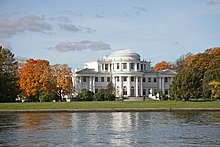Yelagin Palace
59°58′45″N 30°16′12″E / 59.9793°N 30.27°E


Yelagin Palace (Елагин дворец; also Yelaginsky or Yelaginoostrovsky Dvorets) is a
Palladian villa on Yelagin Island in Saint Petersburg, which served as a royal summer palace during the reign of Alexander I. The villa was designed for Alexander's mother, Maria Fyodorovna, by the architect Carlo Rossi. It was constructed in 1822 on the site of an earlier mansion built during the rule of Catherine the Great. The house was destroyed during World War II but was rebuilt and currently houses a museum.[1]
The isle to the north of the imperial Russian capital owes its name to its former proprietor,
Count Cagliostro was summoned by Yelagin to help him in these activities, but fled the island after Yelagin's secretary had slapped him in the face.[3]
After the Dowager Empress
Vasily Demuth-Malinovsky, and Stepan Pimenov.[4]
After Maria Feodorovna's death, the palace remained deserted for long periods of time.
Nicholas II leased it to his prime ministers such as Sergei Witte, Pyotr Stolypin, and Ivan Goremykin. In June 1908 Stolypin lived in a wing of the Yelagin Palace;[5] in July 1914 also the Council of Ministers under Ivan Goremykin convened there.[6] The Bolsheviks turned the palace compound into "a museum to the old way of life". In the siege of Leningrad it was damaged by a shell and burnt to the ground.[4]
The house was rebuilt in the 1950s to serve as a resort for workers.glassware. The entrance is guarded by two lion sculptures, inspired by the Medici lions in Florence.
References
- ^ "Кеплер.ру – интернет-магазин наблюдательной оптики". kepler.ru. Retrieved Apr 9, 2020.
- ^ "Елагин дворец в Санкт-Петербурге". www.spb-guide.ru. Retrieved Apr 9, 2020.
- ^ Veĭdemeĭer, Aleksandr Ivanovich (1846). "Двор и замѣчательные люди в Россіи, во второй половинѣ XVIII столѣтія".
- ^ a b "Saint Petersburg encyclopaedia". www.encspb.ru. Retrieved Apr 9, 2020.
- ^ Leyda, Jay (Apr 9, 1983). "Kino : a history of the Russian and Soviet film". Princeton, N.J. : Princeton University Press. Retrieved Apr 9, 2020 – via Internet Archive.
- ISBN 9780374712129. Retrieved Apr 9, 2020 – via Google Books.
- ^ "Yelagin Palace in St. Petersburg, Russia". www.saint-petersburg.com. Retrieved Apr 9, 2020.
External links
Wikimedia Commons has media related to Yelagin Palace.
